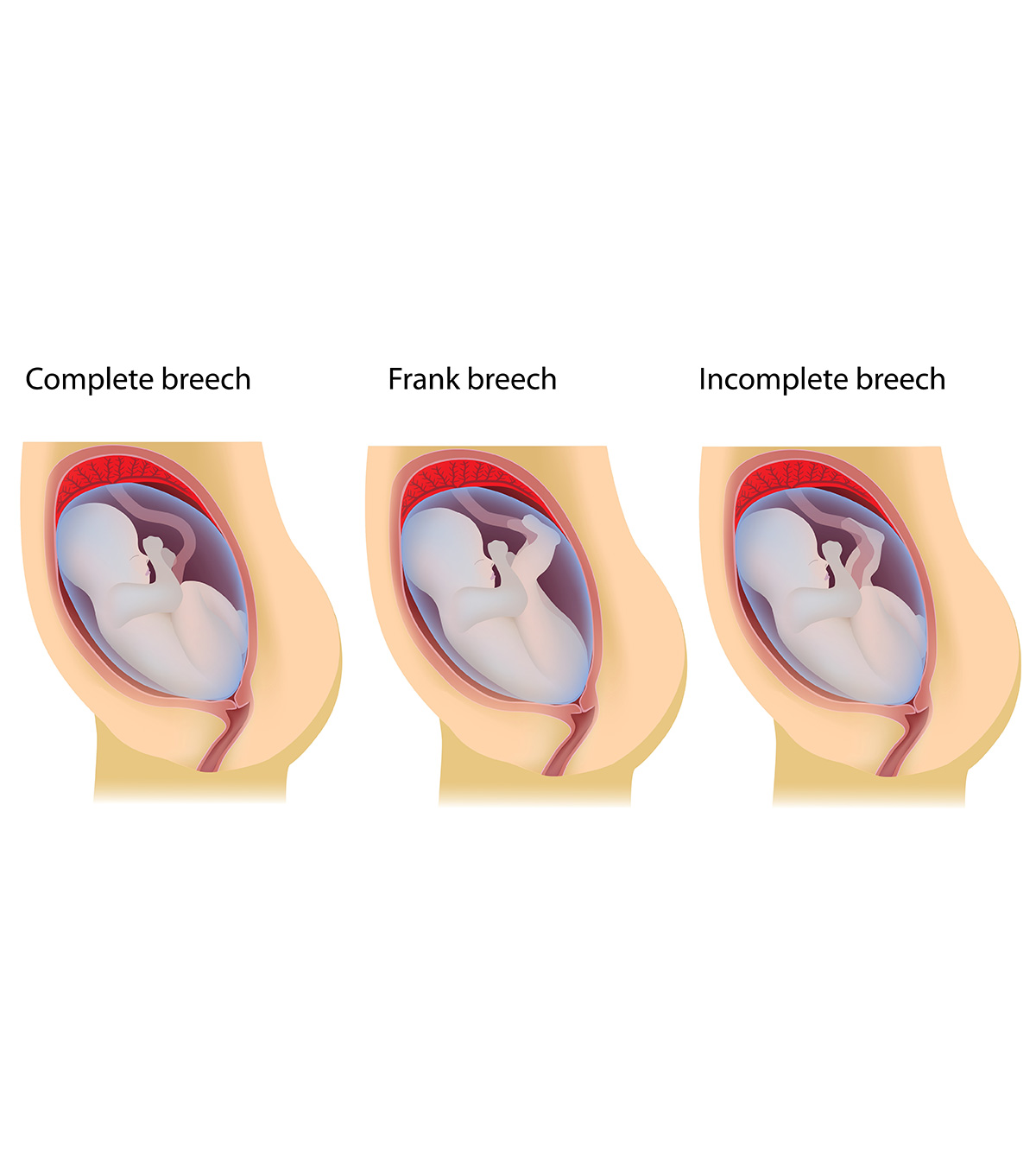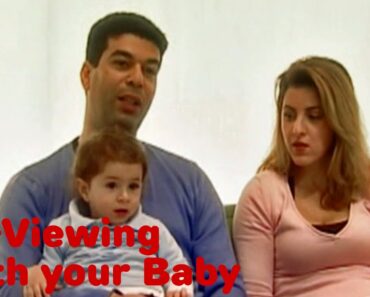image: Shutterstock
A fetus can usually move the head down towards the birth canal while approaching the due date. This is called a vertex presentation. In some cases, the fetus’ buttocks, feet, or both move downward instead of the head, causing them to come out first during the delivery. This is known as a breech presentation. Nearly 3-4% of full-term births can be breech births (1).
Babies born breech may slightly have a higher risk of developing birth defects. Failure to move to the intrauterine position before birth may also occur as a result of congenital malformations. However, not all babies born with breech presentation have congenital anomalies.
Read this post to know about the types, defect rates, associated disabilities, problems, and prevention of breech birth in babies.
Types Of Breech Babies
Image – https://www.shutterstock.com/image-illustration/types-breech-birth-positions-163605515
There are three types of breech positions (2).
- Frank breech: This is the most common breech position where buttocks are delivered first. Legs are positioned up in front of the body and feet near the head.
- Complete breech: The buttocks are presented near the birth canal. The knees are bent, and the feet are placed near the buttocks.
- Incomplete breech: Baby’s buttocks and a foot are presented in the birth canal. The other leg stays up towards the body like seen in the frank breech. If one foot and buttocks emerge first, it is called footling breech. If both feet appear first since both legs are extended, it is called double footling breech.
What Rate Of Breech Babies Have Birth Defects?
There may be a slight increase in the number of birth defects among breech babies. A study noted that 11.7% of infants born breech had at least one congenital anomaly. In comparison, only 5.1% of babies born with vertex presentation had any congenital anomaly (3). This occurred regardless of the term of pregnancy.
The study established that breech presentation at birth may indicate congenital anomalies. Congenital defects could prevent the baby from moving to a cephalic position (head down) before delivery. Although the breech position may indicate a possible congenital anomaly, it may not be noted in all breech babies.
What Birth Defects Are Associated With Breech Babies?
Studies have shown that the following birth defects are commonly seen in babies born breech (4).
- Congenital hip deformity or hip dysplasia: Breech babies may have congenital hip problems, such as hip dysplasia, since their movements in the womb can be limited. It can be especially common in frank breech where knees are extended.
- Nervous system and musculoskeletal system malformations: Breech babies may have a higher risk of neurological or musculoskeletal disorders due to reduced or lack of movements in the womb. These malformations can be the reason for the reduced ability to turn into the cephalic presentation (vertex) before delivery.
- Structural deformities of fetal ears, face, eyes, and neck: These conditions may affect the fetal rotation to a cephalic presentation near the due date.
- Cleft lip or cleft palate, respiratory and circulatory system problems: These conditions may increase breech presentation due to polyhydramnios (too much amniotic fluid).
- Genital and urinary malformations: These defects may contribute to breech position due to polyhydramnios (too much amniotic fluid) or oligohydramnios (too little amniotic fluid).
- Chromosomal anomalies: Intrauterine growth restrictions associated with chromosomal anomalies may cause breech presentation.
- Down syndrome: Babies with Down syndrome could be born breech due to their inability to turn to vertex position before birth.
Studies have shown that various malformations are associated with breech birth except for digestive system problems. Malformations may primarily cause the baby to fail to rotate to the cephalic presentation before birth.
Complications Of Breech Presentation
Umbilical cord prolapse and head entrapment are significant problems of breech delivery (5). If the umbilical cord is compressed during breech birth, it could restrict the blood and oxygen flow to the fetus.
Breech birth can be associated with fetal distress in many cases. Delay in delivery and meconium-stained amniotic fluid can be a reason for it. There is also an increased risk of hip dislocation during a breech delivery.
How To Prevent Problems Of Breech Births?
There is no way to prevent birth defects in breech babies. However, problems associated with breech birth could be prevented by changing the position of the fetus before the delivery. The following procedures or techniques may help to avoid breech birth.
1. External cephalic version
It is a procedure that turns the fetus from breech or side-lying (transverse) position to head-down or vertex position before the labor. This is usually done at 37 weeks of gestation before the labor begins but rarely done during the labor before the amniotic sac ruptures (6).
Doctors may give tocolytic injections before the procedure to prevent uterine contractions and relax the uterus. After visualizing the baby’s position, placental location, and amniotic fluid volume, the doctor may gently push the abdomen to change the position. The fetus is closely monitored with fetal ultrasound and electronic fetal heart monitoring. If the first attempt fails, the second attempt may be made under epidural anesthesia.
Although complications are rare in the external cephalic version, there is always a possibility. Therefore, the procedure is always done in a hospital where women can have emergency C-sections. It is possible to have a vaginal birth after a successful external cephalic version. If there is no complication after an unsuccessful version, a scheduled cesarean section is done.
2. Chiropractic care
The Webster technique is a chiropractic method to move the fetus from breech position to normal position. This technique focuses on relaxing the uterus and ligaments, reducing stress on the pelvis. This technique is based on the theory that a more relaxed uterus lets the breech baby turn naturally.
Although it is attempted in chiropractic care, a few existing scientific studies backing the techniques are weak in conclusion (7).
Breech birth can be associated with congenital disabilities. However, it can’t be said that all babies delivered in breech positions may have disabilities, or babies born in the cephalic presentation are healthy. All newborns should undergo routine screening to identify their health conditions. A mother with a suspected breech position of the fetus may visit the hospital for early interventions. Doctors may often suggest a cesarean section after a prenatal ultrasound if there are any risks for the baby if delivered vaginally.


































